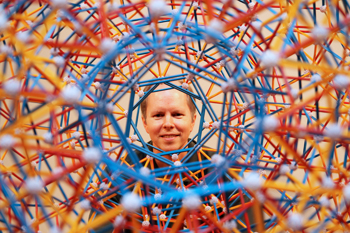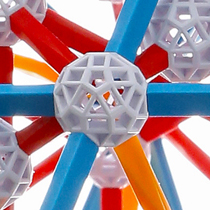
Zometool is a mathematically-precise plastic construction set for building a myriad of geometric structures, from simple polygons to Platonic solids, from models of DNA molecules to geodesic domes, from “shadows” of four-dimensional figures to works of art. It is also a fantastic educational tool, as it facilitates mathematical discovery while unleashing creativity. This page provides a brief introduction and a growing collection of resources about Zometool. Comments, questions, and suggestions are welcome! Please contact Dr. Chris Hill.
About me: I'm a Zometool enthusiast (a.k.a. a Zomer). I love building with it and using it as a teaching tool. I have run several Zometool workshops and "barn raisings" with middle school and high school students and am looking for opportunities to do more.

This section provides an overview of how Zometool "works." However, it is not necessary to know any of this information before using Zometool. Zometool is exceedingly user-friendly.
Zometool has two types of parts: round connector balls and color-coded struts. Each connector ball has 62 holes: 30 rectangular holes, 20 triangular holes, and 12 pentagonal holes. The colors of the struts indicate into which holes in the balls they will fit. Blue struts fit into the rectangular holes, yellow struts fit into the triangular holes, and the red struts and green struts both fit into the pentagonal holes. However, a green strut features two bends which cause it to point in different directions than a red strut. A connector ball allows for construction in 92 different directions.
Each color of strut comes in short, medium, and long sizes. Red struts also come in an even shorter “hypershort” size. For each color of strut, the ratio between the lengths of one size of strut and the next smaller size (if there is one) is the golden ratio, which is about 1.618. (For computing such ratios, the “length of a strut” is equal to the distance between the middle of the node at one end of the strut to the middle of the node at the other end.) An elegant consequence of this fact is that for each color, the length of a long strut equals the length of a medium strut connected to a short strut. In brief, a long equals a medium plus a short. Similarly, in red, a medium equals a short plus a hypershort.
Different types of struts are required for the construction of different types of structures. For example, a regular dodecahedron can be built with blue struts of the same size, a rhombic dodecahedron with yellow struts of the same size, a rhombic triacontahedron with red struts of the same size, a regular tetrahedron with green struts of the same size, and more elaborate structures with combinations of strut types and sizes.
To make it easier to specify parts for a project, the strut types "blue," "yellow," "red," and "green" are abbreviated "B," "Y," "R," and "G," and the strut sizes "hypershort," "short," "medium," and "long" are denoted "00," "0," "1," and "2," respectively. For example, a long blue strut is a B2, a medium yellow strut is a Y1, a short green strut is a G0, and a hypershort red strut is an R00.
Prior to 2011, Zometool offered blue, yellow, and red struts in a size 3 that was longer than size 2 by a factor of the golden ratio. Per the comments about the golden ratio above, in a given color, a size 3 strut has the same length as a size 2 strut connected to a size 1 strut. Nevertheless, it's unfortunate that size 3 struts were discontinued. They allowed simple models to be built on a grander scale, and a few constructions (such as the compound of ten triangular prisms—see Projects, below) require them.
Since the ratio between the lengths of one size of strut and the next smaller size is the same for all types of struts, a Zometool model can be scaled up (respectively, down) by replacing each strut with the next larger size (respectively, smaller size), provided that size strut exists.